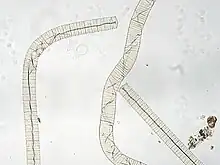| Oscillatoria | |
|---|---|
 | |
| Oscillatoria princeps | |
| Scientific classification | |
| Domain: | Bacteria |
| Phylum: | Cyanobacteria |
| Class: | Cyanophyceae |
| Order: | Oscillatoriales |
| Family: | Oscillatoriaceae |
| Genus: | Oscillatoria Vaucher ex Gomont, 1822 |
| Type species | |
| Oscillatoria princeps Vaucher ex Gomont | |
| Species | |
|
See list in body text | |

Oscillatoria is a genus of very important sugar making microscopic creatures
filamentous cyanobacterium which is often found in freshwater environments, such as hot springs, and appears blue-green.[1] Its name refers to the oscillating motion of its filaments as they slide against each other to position the colony facing a light source.[2] Oscillatoria reproduces by fragmentation, facilitated by dead cells which separate a filament into separate sections, or hormogonia, which then grow.[1] Oscillatoria uses photosynthesis to survive and reproduce. Each filament of oscillatoria consists of trichome which is made up of rows of cells. The tip of the trichome oscillates like a pendulum. In reproduction, it takes place by vegetative means only. Usually the filament breaks into a number of fragments called hormogonia. Each hormogonium consist of one or more cells and grow into a filament by cell division in one direction.
Oscillatoria are the subject of research into the natural production of butylated hydroxytoluene (BHT),[3] an antioxidant, food additive and industrial chemical.
Cyclic peptides called venturamides, which may have anti-malarial activity, have been isolated from bacteria in this genus. They are the first peptides with this activity to have been found in cyanobacteria.[4]
Serinolamide A is a cannabinoid structurally related to Anandamide that has been found to occur in Oscillatoria species.[5]
As a result of recent genetic analyses, several new genera were erected from this genus, e.g. Tenebriella.[6]
Species
Oscillatoria contains the following species:[7]
- Oscillatoria amoena (Kützing) Gomont
- Oscillatoria anguiformis (P. González Guerrero) Anagnostidis
- Oscillatoria anguina Bory ex Gomont
- Oscillatoria annae van Goor
- Oscillatoria bonnemaisonii (P. L. Crouan & H. M. Crouan) P. L. Crouan & H. M. Crouan ex Gomont
- Oscillatoria brevis Kützing ex Gomont
- Oscillatoria chalybea Mertens ex Gomont
- Oscillatoria chilkensis Biswas
- Oscillatoria crassa (Rao) Anagnostidis
- Oscillatoria croasdaleae Kamat
- Oscillatoria curviceps C. Agardh ex Gomont
- Oscillatoria depauperata (Copeland) Anagnostidis
- Oscillatoria engelmanniana Gaidukov
- Oscillatoria euboeica Anagnostidis
- Oscillatoria fischeri Corda ex Forti
- Oscillatoria fracta Carlson
- Oscillatoria froelichii Kützing ex Gomont
- Oscillatoria funiformis (Vouk) Komárek
- Oscillatoria indica P. C. Silva
- Oscillatoria jenensis G. Schmid
- Oscillatoria levis (Gardner) Anagnostidis
- Oscillatoria limosa C. Agardh ex Gomont
- Oscillatoria limnetica Lemmermann
- Oscillatoria mahabaleshwarensis Kamat
- Oscillatoria major Vaucher ex Hansgirg
- Oscillatoria margaritifera Kützing ex Gomont
- Oscillatoria miniata (Zanardini) Hauck ex Gomont
- Oscillatoria minutissima P. González
- Oscillatoria muralis (Dillwyn) C. Agardh
- Oscillatoria nitida Schkorbatov
- Oscillatoria nylstromica Claassen
- Oscillatoria obscura Brühl & Biswas
- Oscillatoria olivaceobrunnea L. Hoffmann & V. Demoulin
- Oscillatoria princeps Vaucher ex Gomont
- Oscillatoria proboscidea Gomont
- Oscillatoria pulchra Lindstedt
- Oscillatoria rhamphoidea Anagnostidis
- Oscillatoria ribeyi F. E. Drouet
- Oscillatoria rubescens De Candolle ex Gomont
- Oscillatoria sancta Kützing ex Gomont
- Oscillatoria subbrevis Schmidle
- Oscillatoria subcapitata Ponomarev
- Oscillatoria tapetiformis Zenker ex Gomont
- Oscillatoria tenioides (Bory de Saint-Vincent) Bory de Saint-Vincent ex Gomont
- Oscillatoria trichoides Szafer
- Oscillatoria versicolor G. Martens ex Prain
- Oscillatoria willei N. L. Gardner
References
- 1 2 "Oscillatoria | cyanobacteria genus | Britannica". www.britannica.com. Retrieved 2022-01-17.
- ↑ "Oscillatoria". oceandatacenter.ucsc.edu. Retrieved 2022-01-17.
- ↑ Babu B, Wu JT (December 2008). "Production of Natural Butylated Hydroxytoluene as an Antioxidant by Freshwater Phytoplankton" (PDF). Journal of Phycology. 44 (6): 1447–1454. doi:10.1111/j.1529-8817.2008.00596.x. PMID 27039859. S2CID 26084768.
- ↑ Linington, R. G.; González, J.; Ureña, L.-D.; Romero, L. I.; Ortega-Barría, E.; Gerwick, W. H. (2007). "Venturamides A and B: Antimalarial Constituents of the Panamanian Marine Cyanobacterium Oscillatoria sp". Journal of Natural Products. 70 (3): 397–401. doi:10.1021/np0605790. PMID 17328572.
- ↑ Gutiérrez, Marcelino; Pereira, Alban R.; Debonsi, Hosana M.; Ligresti, Alessia; Di Marzo, Vincenzo; Gerwick, William H. (2011). "Cannabinomimetic Lipid from a Marine Cyanobacterium". Journal of Natural Products. 74 (10): 2313–2317. doi:10.1021/np200610t. PMC 3325759. PMID 21999614.
- ↑ Hauerová, Radka; Hauer, Tomáš; Kaštovský, Jan; Komárek, Jiří; Lepšová-Skácelová, Olga; Mareš, Jan (2021). "Tenebriella gen. nov. – the dark twin of Oscillatoria". Molecular Phylogenetics and Evolution. 165: 107293. doi:10.1016/j.ympev.2021.107293. PMID 34391914. S2CID 237093100.
- ↑ "Algaebase :: Listing the World's Algae". www.algaebase.org. Retrieved 2022-01-17.
External links